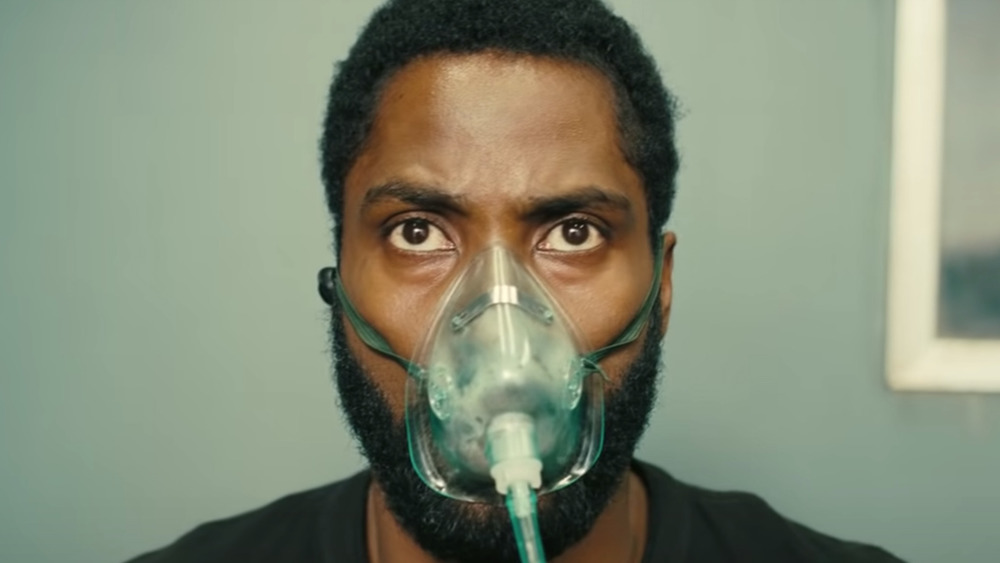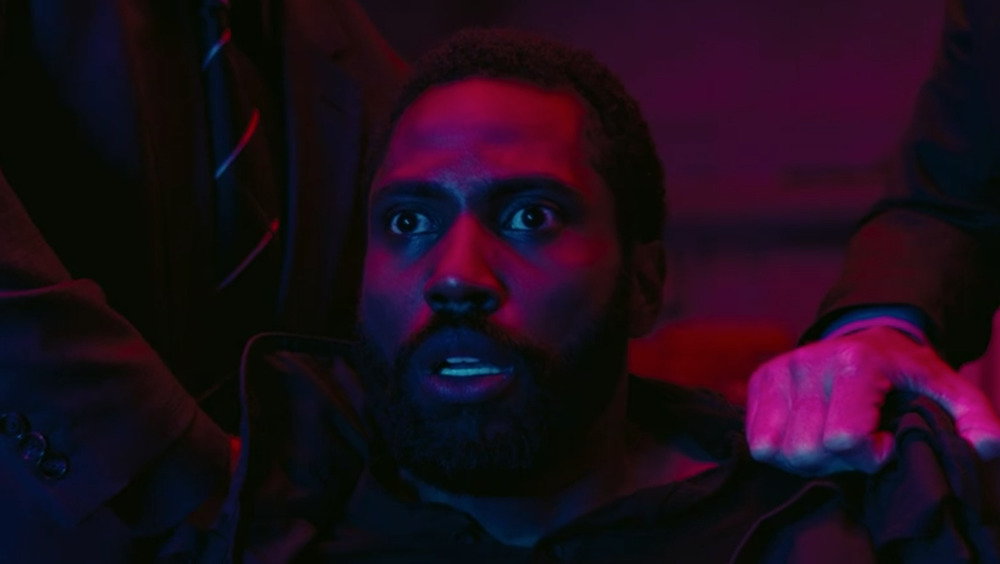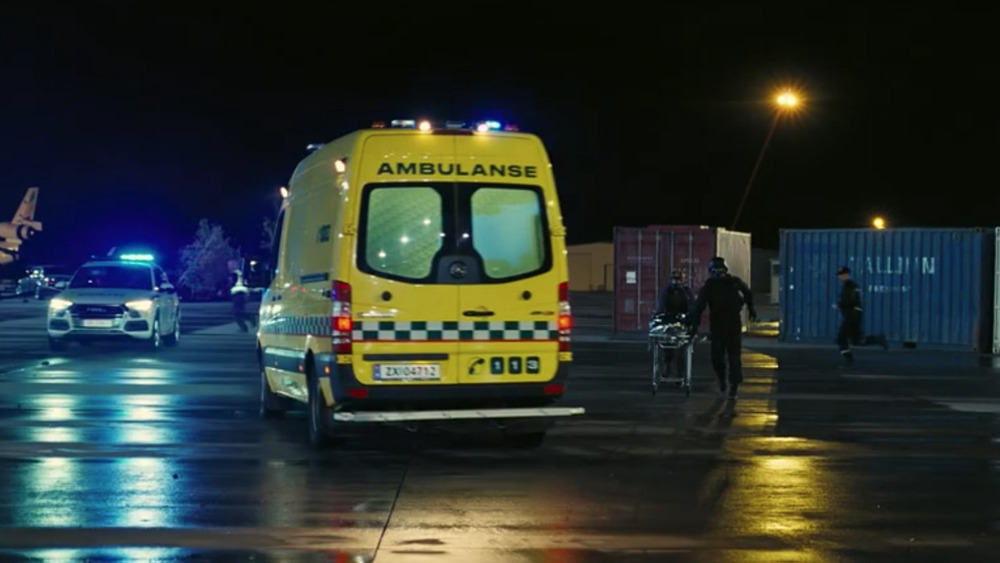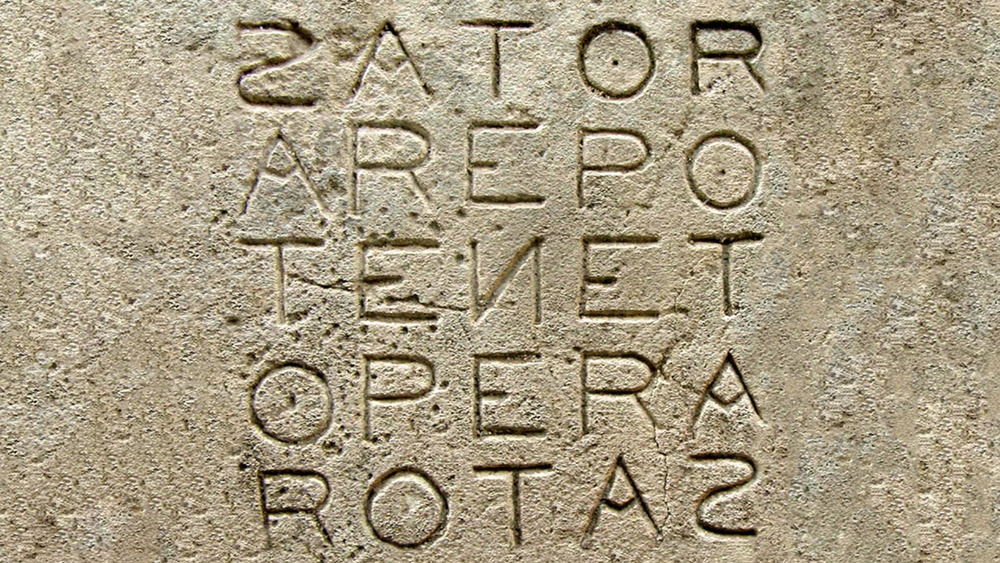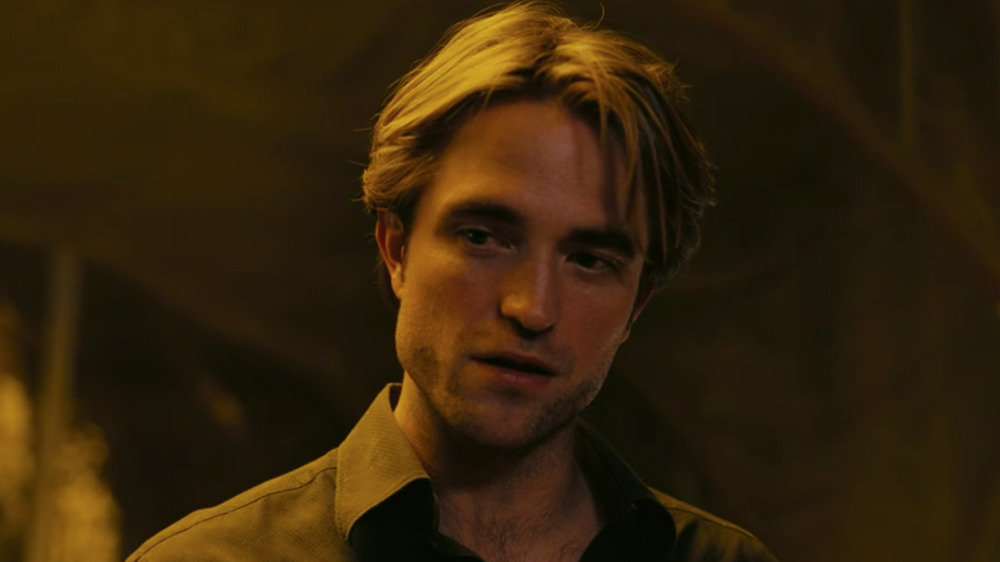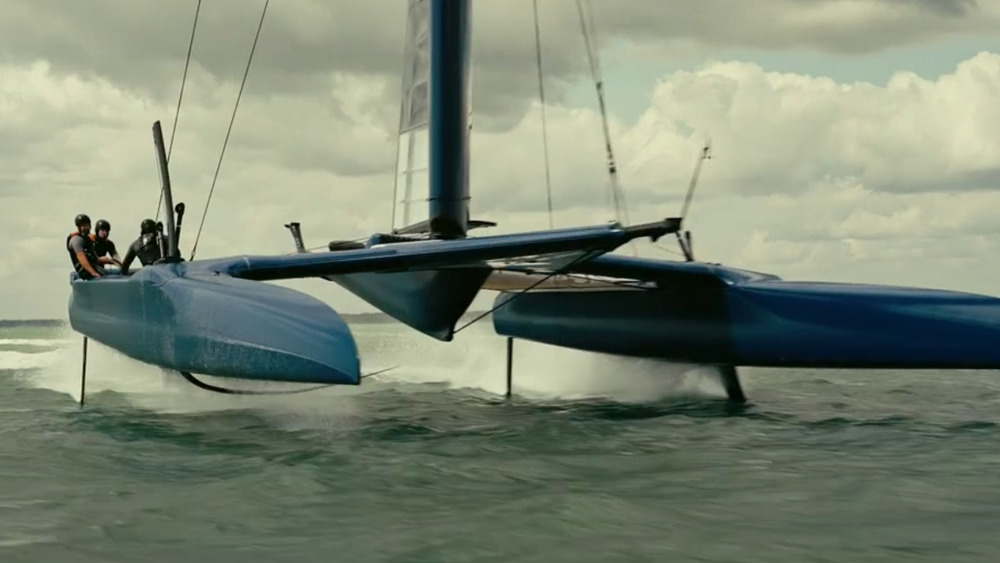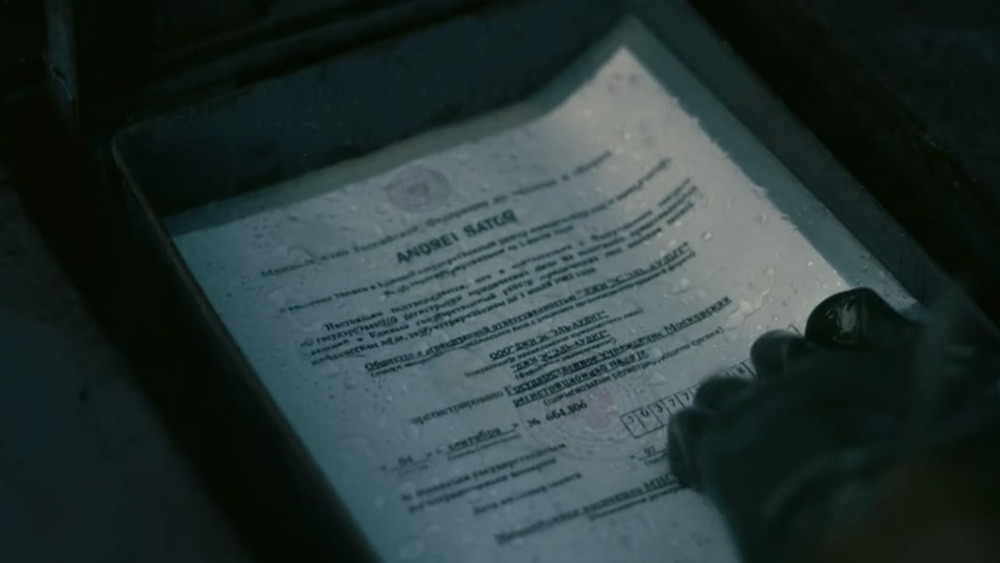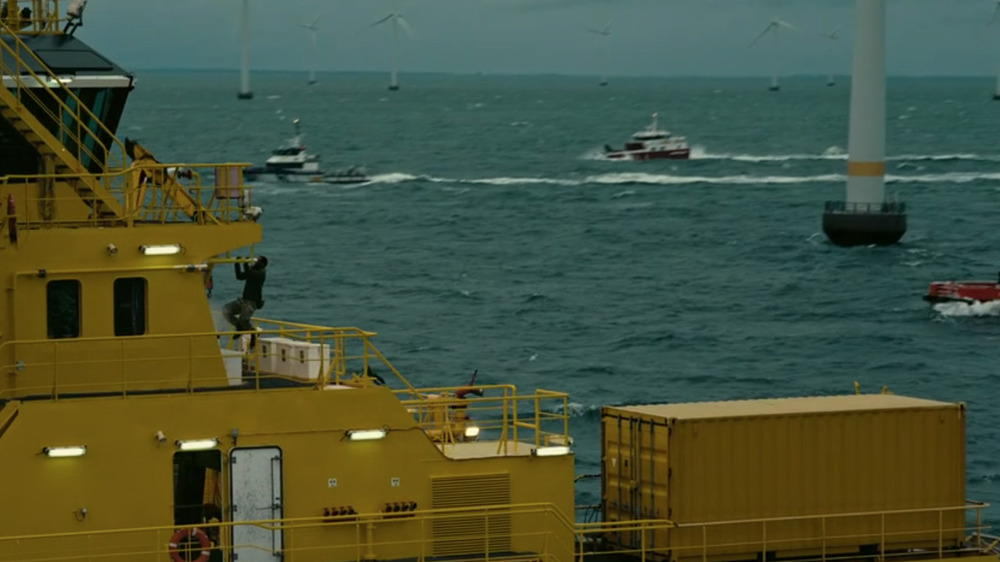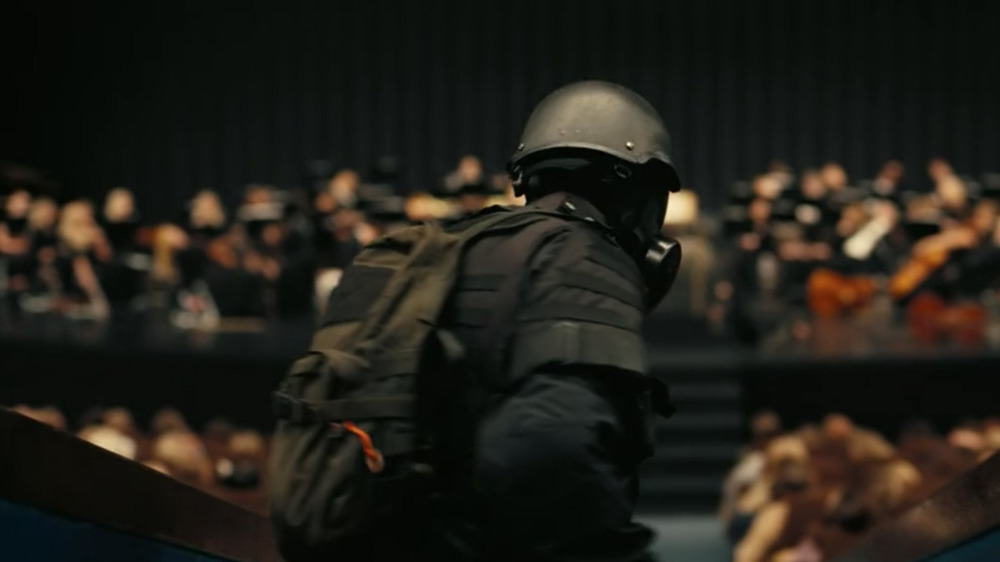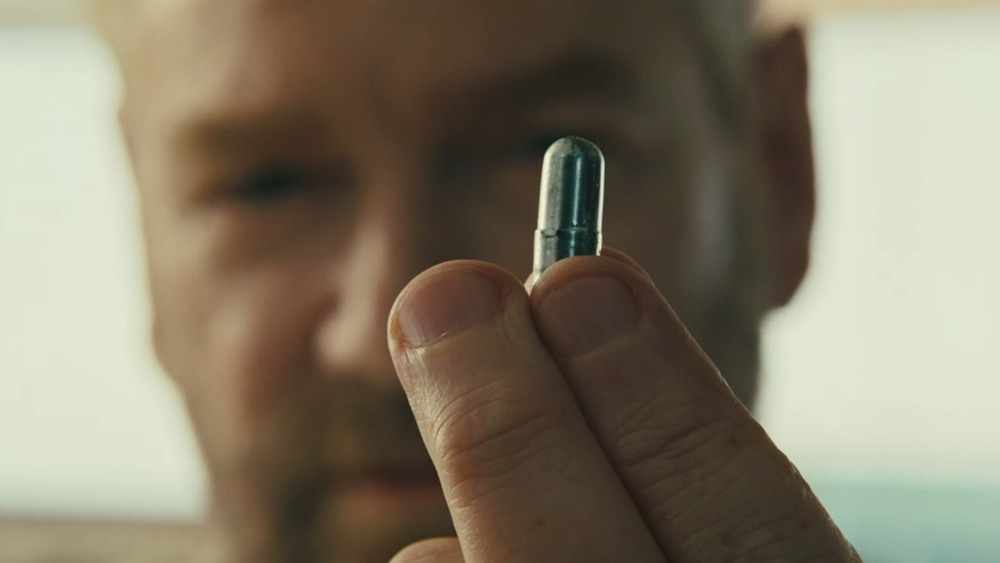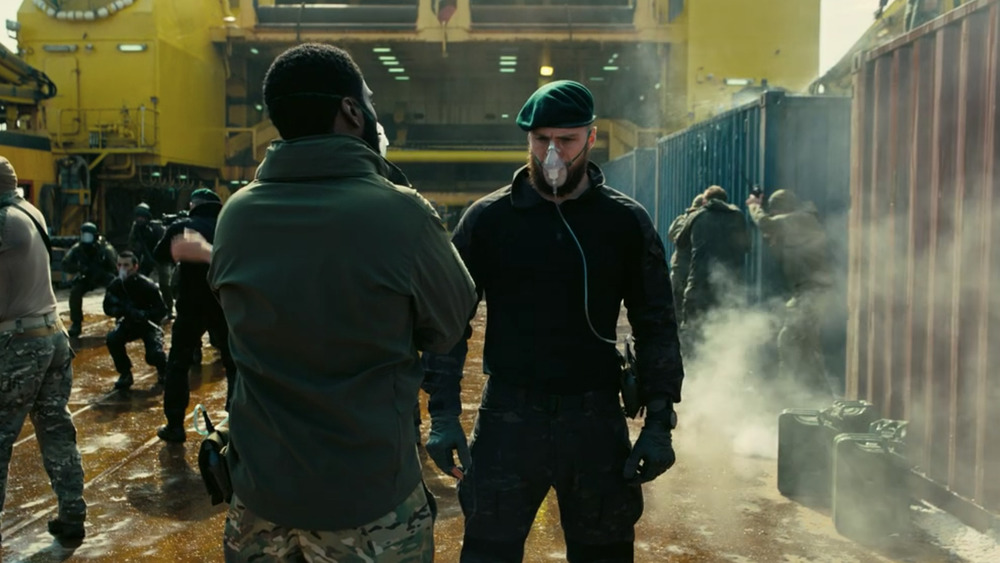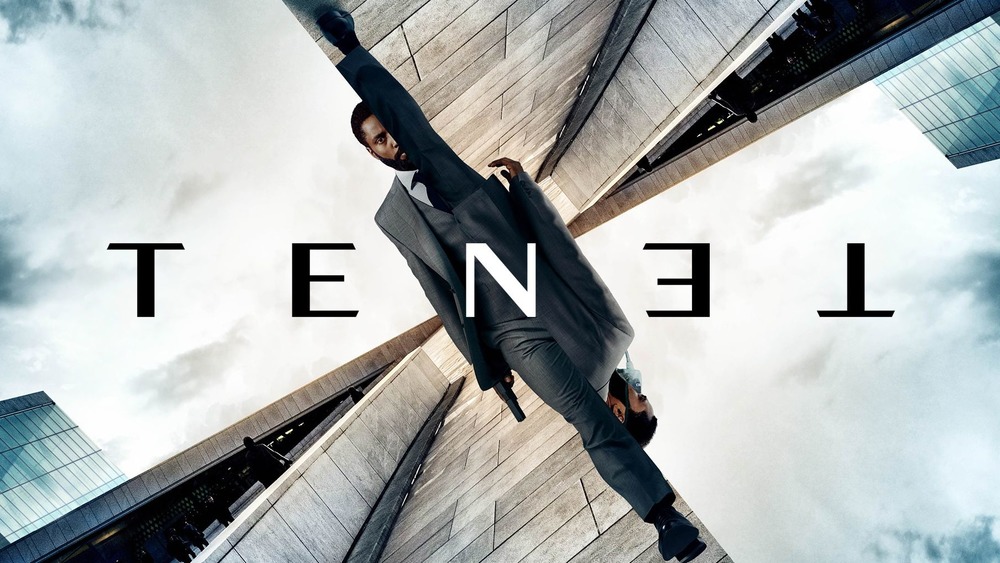Small Details You Missed In Tenet
The road to brain-melting cinema has been well-tended by Christopher Nolan. Anyone with overwhelming desires for high-octane brain food need look no further than Tenet, the legendary director's latest feast of cerebral candy. It is a whirlwind visual delight, built atop an elaborate concept Nolan uses to dive deeper into his fascination with warping time. Tenet is a deconstruction of how we perceive reality, and it demands multiple viewings.
Your first trip through the world of Tenet is a non-stop barrage of brain twisters that leave you with little time to soak in any nuance. The concept of "time inversion," a core element of the film, only becomes fully comprehensible moments before the credits roll — if not even further into the rest of your week, as you debate the subject with other fans. Indeed, Tenet can feel frenetic and rushed upon one's first viewing, and this quality allows a myriad of Easter eggs, foreshadowing, and world expansion to skate right past you. That's why we sat down for multiple viewings of the latest Nolan flick, in order to better process all its intricacies. Our brains are now a bowl of oatmeal, but we have emerged with a fistful of details that zipped across the screen without our knowledge during our first viewing. These are the small details you missed in Tenet.
Warning: Spoilers are abundant from here on out!
Red versus blue
If you've watched Tenet, then you have a basic understanding of time inversion. You know there are turnstiles which can reverse an object's entropy, allowing that object to move backwards through time. As good and evil battle over reality, processing who is inverted and who isn't can be a tedious task. Lucky for us, the filmmakers laced Tenet with color theory, to help us better identify these attributes.
In the final battle, soldiers are given arm bands that are either blue or red, to signify if they are inverted or not. Red signifies an object that is not inverted and moving with the usual flow of time. Blue signifies an object which is inverted and moving against the flow of time. You may not have realized it, but these identifiers are scattered throughout the film. When Sator (Kenneth Branagh) is tormenting his wife, Kat (Elizabeth Debicki), she is sporting a bright red dress. When the man we know only as the Protagonist and Neil (John David Washington and Robert Pattinson) find the first turnstiles at Freeport, the doors they walk through are labeled with red and blue signs. The most glaring moment comes when Sator interrogates the Protagonist and shoots Kat with an inverted round. The room is bathed in blue light on one side, while the room on the other side of the glass is lit with red. Keying in on the reds and blues will make another viewing of Tenet a completely different experience.
Priya sneakily slips the word "tenet" into a sentence when she first meets the Protagonist
After the Protagonist wakes up from his faux-suicide pill, he is greeted by an official who informs him of the existence of Tenet, an organization fighting an onslaught from the future. The Protagonist is informed that using the word will launch him further down the rabbit hole. You might think the word is only used in this manner once, when he meets with scientists to learn the mechanics of time inversion. But in actuality, other people drop the word in subtle ways.
Recall when Neil and the Protagonist execute their reverse bungee jump, and our hero meets Priya, the supplier of an inverted bullet found earlier. She states, "To say anything about a client would violate the tenets he lives by." From her viewpoint, she has already met the Protagonist, but he hasn't met her yet. This is a sneaky way for Priya to check which version of the Protagonist she is talking to. Her dialogue also tells us that she is viewing the conceptual core with a "many worlds" mentality, which is incorrect. She alludes to this during an ominous conversation when she states, "If that universe can exist, we don't live in it." Her inability to correctly process cause and effect as non-linear results in a bullet from the Protagonist.
The characters pass by their inverted selves while escaping the airport
Undoubtedly, the most hard-hitting scene in Tenet comes when we discover the inverted man the Protagonist battled at Freeport is actually himself. After Kat is hit with an inverted round, the crew invert themselves in order for the wound to properly take its course without killing her. In order to flip back around again, they venture back to Freeport to jump into the turnstiles they found the week before. Their plan is to sneak in during the panic after the plane crashes into the building from their earlier heist. A hypnotic sequence takes place in which they are running through the plane crash site while the world moves in reverse around them.
It is after this shot that the Protagonist is thrust into his altercation with himself. The fight likely distracted you from some neat little details, like the Protagonist's view of running out to tell Neil it's all clear, which cuts to Neil's view as he watches the Protagonist run by in reverse. The group hijacks an ambulance and are able to escape the scene unharmed, for the most part. A clever detail emerges as they are driving off in the ambulance: You can see the inverted version of the characters moving backwards away from the plane crash with Kat on the gurney. This is one of several moments when Tenet's characters are completely unaware they are passing by different inverted versions of themselves.
The Sator Square
Andrei Sator is more than just a menacing sounding name. The primary villain's moniker is a reference to the real-life Sator Square, a palindromic square featuring key Latin words: Sator, Arepo, Tenet, Opera, Rotas. Representations of the Sator Square have been found in the ruins of Pompeii and scattered throughout history. It also features heavily in the world of magic and folklore. Palindromes are considered by many to be immune from tampering by the devil, due to the belief that the letters would confuse him with their repetition.
Christopher Nolan wove all the words from the Sator Square into the plot of Tenet. "Sator" is the name of the film's villain, of course. "Arepo" is the name of the artist that Kat is running a con with by selling forged art pieces. The word "Tenet" is featured heavily, obviously. "Opera" is in reference to the Kyiv Opera siege at the opening of the film. And "Rotas" is the name of the security company working at Freeport where Neil and the Protagonist find the first set of turnstiles. How very clever, Mr. Nolan.
The grandfather paradox
Tenet is not a time travel movie in the typical sense. Consider Neil and the Protagonist's discussion of the "grandfather paradox," which posits that if you were to go back in time and kill your own grandfather, you would cease to exist, resulting in a logical loop. Supposedly, the folks of the future believe that if they harm their own grandfather, there won't be consequences — or at least, none more severe than the planetary doom they're already marching towards. If their line of thinking is accurate, then the fact that everything is taking place means they failed. The mere existence of Tenet's events hints to the outcome. Had they succeeded in triggering the algorithm, then time wouldn't be flowing in our direction.
This could also be true according to the film's other events, like Kat killing Sator in the past. This would mean the past can be affected without consequence, because there is a version of Sator running amok long after his demise. This is still left ambiguous though, because dialogue tells us there is the possibility that this is a future version of Sator. This would mean Sator and Kat both inverted and came back to the same moment. So, in reality, we still don't know which take on the grandfather paradox is true within the world of Tenet. That feels about right for a Nolan time-bender flick.
The blue sailboat
An early step on the Protagonist's path to getting close to Sator is their sailboat adventure, with Kat on board as well. Kat takes the opportunity to unhook Sator's harness and send him tumbling into the water, because apparently Sator can't swim. Or maybe they were just moving really fast on the water? Either way, it almost kills Sator. The Protagonist's rescue helps him move closer within Sator's circle, but the sailboat scene has more meaning to it than that.
Different parts of this scene are presented as a visual metaphor for the movie's time mechanics. Consider the color of the sailboat, which you might have failed to notice. The sailboat is blue. It's so blue, in fact, that it feels intentional. Added to this is the shot of the sailboat turning around, against the current. This is a nod to how time inversion works: It moves upstream, against the usual flow of time.
Andrei Sator's name is in the "first" capsule from the future
During a conversation involving the heist of plutonium-241, Sator discusses his beginnings, rooted in digging up plutonium in the ruins of his hometown. The whole truth behind the story is shown visually, while his words with the Protagonist are more vague. We see images of Sator finding the first capsule from the future. After realizing the case is filled with gold bars and instructions, he grabs his shovel and kills the person next to him. There is a small detail to take note of in this scene, which makes the whole situation even more fascinating, albeit more complex.
The case Sator discovers is filled with a fortune in gold bars, but pay close attention to the instructions he finds with that gold. On those papers, you see his name, "Andrei Sator," printed on the front. Given that this is his first time communicating with the future, how did they know he would be the one to find this capsule? This could mean that his first communication with the future, in which they learn his name, may not have happened for him yet. Is your brain melting yet? Because the timeline for Sator gets a bit too hectic for us once we pull on this particular thread.
The Protagonist passes himself while doing pull-ups
After the Protagonist is told about Tenet, he is dropped off at sea, among a scattering of windmills. Our assumption is that he is waiting for another boat to take him further to his next destination. While he is waiting, we see him climb a ladder inside the windmill and do some pull-ups. Upon first watch, this routine seems to exist only to display his level of discipline. But this scene comes back into play in a brief moment later in the film.
Later on in Tenet, the Protagonist is inverted, and travels back to the day an explosion occurs in Stalsk-12 (which happens at the same time as the opera siege in the opening of the film). While working his way back, there is a shot of him on a big yellow barge, doing pull-ups as the ship moves in reverse. This area of the ocean is actually the same windmill-filled area seen earlier in Tenet. Thus, this scene shows the Protagonist moving by his past self. Also, when his earlier version leaves the windmill, it is on a blue boat, while all other boats on the water are red. In the later scene on the yellow barge, you can see a blue boat moving backwards next to a couple of red boats. Remember: The entire movie is a palindrome.
The red string
There are a slew of confusing moments all throughout Tenet, and wrapping your brain around all of them can result in a tension headache. One thing we know for sure, though, is that Neil is marching towards his doom the last time we see him. While down in the cavern trying to get the algorithm, the Protagonist spots a piece of red string on the backpack of the inverted soldier who is lying dead on the other side of the locked gate. As Neil is walking away, we see that same piece of red string on his backpack.
This isn't the first time in Tenet that we see that key piece of string, though. In the opening of the film, the Protagonist is a player in the Kyiv Opera heist. There is a moment when he is rescued by what appears to be a man wielding an inverted bullet. As the man turns to run off, the Protagonist spots that same piece of string on his backpack. This means the Protagonist was being saved by Neil before they even actually met.
Sator didn't know he had a fake suicide pill
Some Tenet theories make the assumption that the pill the Protagonist takes at the beginning of the film successfully killed him. They claim that we are witnessing his end, and the movie is moving towards how it all started. The dialogue when he wakes up makes it clear how untrue that is, however. That said, the suicide pill he takes does come back into play later on.
When Sator is contemplating his eventual suicide, he holds up that same pill and states, "I borrowed it from the CIA." He goes on to describe it as "the way the world ends — not with a bang, but with a whimper." This means Sator is unaware of the fact that the pill is a fake, which is a loud statement. It means that even if Kat doesn't kill Sator, he will still fail to set off the algorithm by killing himself. This is basically saying that Sator was always going to lose, no matter what he did. Whatever's happened, happened.
There are several moments when the movie's music is playing backwards
A common complaint about Nolan films criticizes their incredibly loud soundtracks. Sometimes, they can overwhelm the dialogue — and in a movie like Tenet, the dialogue is extremely important. It's a situation that can be easily remedied with subtitles, at least. We're content with the sound levels, because you can't deny how effective the score is in setting the mood. Moreover, there are several key moments in which Tenet's score is particularly creative — and dramatically important.
Composer Ludwig Göransson (Black Panther, The Mandalorian) used a creative approach to ensuring Tenet's score mirrors the film's themes. At various moments in Tenet, such as the interrogation scene, the music is playing backwards. This detail is so intricate and important that Göransson didn't just reverse the soundtrack — he actually had his musicians play the music backwards. It's not the only time he played with the music this way. During the final battle, there are two different scores playing over each other, to match a battlefield featuring inverted and non-inverted soldiers. Göransson went even further in some scenes. When the Protagonist is on a boat with both inverted and non-inverted soldiers training behind him, the music has its rhythm and percussion playing forward, while the orchestra is playing in reverse.
Tenet spells "ten" forward and backward
"This whole operation is a temporal pincer," Neil states, as he marches off to rejoin the battle once again. This is a statement that helps you better understand the movie as a whole — like how the film's ending occurs at the same time as the film's opening. In the end of Tenet, the Protagonist is part of a battle in Stalsk-12, where everyone is fighting over the algorithm. The soldiers we see are performing a "temporal pincer." In the traditional military sense, a "pincer" involves attacking your enemy from two different directions. Take that concept and correlate it with time: The soldiers are attacking from two different directions in time.
The window of time the soldiers work with is 10 minutes on either side of the event. We've come to know everything Christopher Nolan does is intentional, and this chosen amount of time is no exception. The word "Tenet" spells "ten" both forwards and backwards. The title of the movie itself hints to what is going to happen. Compared to some of the items on this list, this particular detail is simple. And yet, like all of them, it is dizzyingly cool when noticed.
